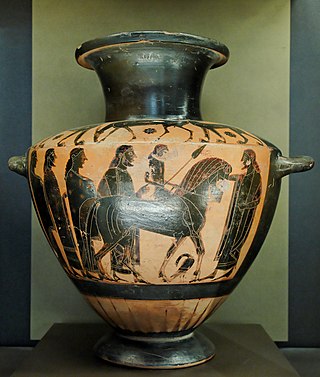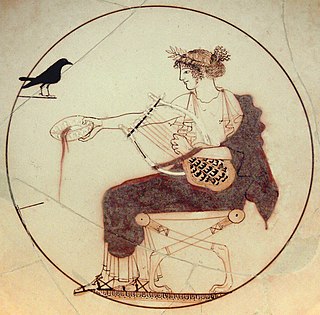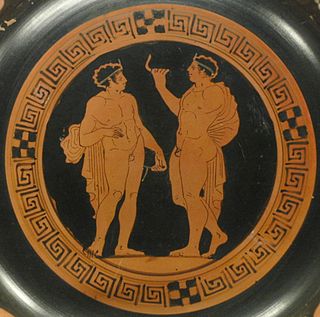
Pottery, due to its relative durability, comprises a large part of the archaeological record of ancient Greece, and since there is so much of it, it has exerted a disproportionately large influence on our understanding of Greek society. The shards of pots discarded or buried in the 1st millennium BC are still the best guide available to understand the customary life and mind of the ancient Greeks. There were several vessels produced locally for everyday and kitchen use, yet finer pottery from regions such as Attica was imported by other civilizations throughout the Mediterranean, such as the Etruscans in Italy. There were a multitude of specific regional varieties, such as the South Italian ancient Greek pottery.

Black-figure pottery painting, also known as the black-figure style or black-figure ceramic, is one of the styles of painting on antique Greek vases. It was especially common between the 7th and 5th centuries BCE, although there are specimens dating in the 2nd century BCE. Stylistically it can be distinguished from the preceding orientalizing period and the subsequent red-figure pottery style.

Exekias was an ancient Greek vase painter and potter who was active in Athens between roughly 545 BC and 530 BC. Exekias worked mainly in the black-figure technique, which involved the painting of scenes using a clay slip that fired to black, with details created through incision. Exekias is regarded by art historians as an artistic visionary whose masterful use of incision and psychologically sensitive compositions mark him as one of the greatest of all Attic vase painters. The Andokides painter and the Lysippides Painter are thought to have been students of Exekias.

Red-figure pottery is a style of ancient Greek pottery in which the background of the pottery is painted black while the figures and details are left in the natural red or orange color of the clay.
Kleitias was an ancient Athenian vase painter of the black-figure style who flourished c. 570–560 BCE. Kleitias' most celebrated work today is the François Vase, which bears over two hundred figures in its six friezes. Painted inscriptions on four pots and one ceramic stand name Kleitias as their painter and Ergotimos as their potter, showing the craftsmen's close collaboration. A variety of other fragments have been attributed to him on a stylistic basis.

The Kleophrades Painter is the name given to the anonymous red-figure Athenian vase painter, who was active from approximately 510–470 BC and whose work, considered amongst the finest of the red-figure style, is identified by its stylistic traits.

Euphronios was an ancient Greek vase painter and potter, active in Athens in the late 6th and early 5th centuries BC. As part of the so-called "Pioneer Group,", Euphronios was one of the most important artists of the red-figure technique. His works place him at the transition from Late Archaic to Early Classical art, and he is one of the first known artists in history to have signed his work.

Lydos was an Attic vase painter in the black-figure style. Active between about 560 and 540 BC, he was the main representative of the "Lydos Group". His signature, ό Λυδός, ho Lydos, inscribed on two vases, is informative regarding the cultural background of the artist. Either he immigrated to Athens from the Lydian Empire of King Kroisos, or he was born in Athens as the son of Lydian parents. In any case, he learned his trade in Athens.

Epiktetos was an Attic vase painter in the early red-figure style. Besides Oltos, he was the most important painter of the Pioneer Group. He was active between 520 BCE and 490 BCE. His name translates as "newly acquired", which is most probably a reference to his slave status.

White-ground technique is a style of white ancient Greek pottery and the painting in which figures appear on a white background. It developed in the region of Attica, dated to about 500 BC. It was especially associated with vases made for ritual and funerary use, if only because the painted surface was more fragile than in the other main techniques of black-figure and red-figure vase painting. Nevertheless, a wide range of subjects are depicted.

The Brygos Painter was an ancient Greek Attic red-figure vase painter of the Late Archaic period. Together with Onesimos, Douris and Makron, he is among the most important cup painters of his time. He was active in the first third of the 5th century BCE, especially in the 480s and 470s BCE. He was a prolific artist to whom over two hundred vases have been attributed, but he is perhaps best known for the Brygos Cup, a red-figure kylix in the Louvre which depicts the "iliupersis" or sack of Troy.

The Nessos Painter, also known as Netos or Nettos Painter, was a pioneer of Attic black-figure vase painting. He is considered to be the first Athenian to adopt the Corinthian style who went on to develop his own style and introduced innovations. The Nessos Painter is often known to be one of the original painters of black-figure. He only worked in this style, which is shown on his name vase in the National Archaeological Museum in Athens. Most of the known Nessos Painter ceramics were found in funerary settings such as cemeteries and mortuaries.

The Amasis Painter was an ancient Greek vase painter who worked in the black-figure technique. He owes his name to the signature of the potter Amasis, who signed twelve works painted by the same hand. At the time of the exhibition, "The Amasis Painter and His World" (1985), 132 vases had been attributed to this artist.

The Antiphon Painter is the Notname for an Athenian red-figure vase-painter active in Ancient Greece during the early 5th century BC. He owes his name to a double Kalos inscription of Antiphon on the dinos stand in the Antique collection of Berlin. He learned his handicraft in the workshop of Euphronios and Onesimos. There he worked closely with them, the Kalmarer Painter and other painters.

Andokides was an ancient Athenian vase painter, active from approximately 530 to 515 BC. His work is unsigned and his true name unknown. He was identified as a unique artistic personality through stylistic traits found in common among several paintings. This corpus was then attributed by John D. Beazley to the Andokides Painter, a name derived from the potter Andokides, whose signature appears on several of the vases bearing the painter's work. He is often credited with being the originator of the red-figure vase painting technique. To be sure, he is certainly one of the earliest painters to work in the style. In total, fourteen amphorae and two cups are attributed to his hand. Six of the amphorae are "bilingual", meaning they display both red-figure and black-figure scenes.

The Pan Painter was an ancient Greek vase-painter of the Attic red-figure style, probably active c. 480 to 450 BC. John Beazley attributed over 150 vases to his hand in 1912:
Cunning composition; rapid motion; quick deft draughtsmanship; strong and peculiar stylisation; a deliberate archaism, retaining old forms, but refining, refreshing, and galvanizing them; nothing noble or majestic, but grace, humour, vivacity, originality, and dramatic force: these are the qualities which mark the Boston krater, and which characterize the anonymous artist who, for the sake of convenience, may be called the 'master of the Boston Pan-vase', or, more briefly, 'the Pan-master'.

The Meleager Painter was an ancient Greek vase painter of the Attic red-figure style. He was active in the first third of the 4th century BC. The Meleager Painter followed a tradition started by a group of slightly earlier artists, such as the Mikion Painter. He is probably the most important painter of his generation. He painted a wide variety of vase shapes, including even kylikes, a rarity among his contemporaries.

The Jena Painter was an ancient Greek vase painter, active in Athens around 400 BC. He mainly painted kylikes in the red-figure technique. His stylistic and chronological place was first determined by the British Classical archaeologist, John D. Beazley. Beazley chose the conventional name "Jena Painter" because a large proportion of the artist's surviving works were in the possession of Jena University. The majority of his 91 known vessels were discovered in the Kerameikos, the potters' quarter of ancient Athens, in 1892. Many of his vessels were exported, for example to Etruria and North Africa. The Jena Painter appears to have had two assistants whose work is described as style B and style C. The Jena Painter would paint the internal images of bowls, and the style B assistant their outsides. The work of the style C assistant is known only from, bowl skyphoi and footless bowls. In contrast to his assistants' rather casual drawings, the Jena Painter is distinguished by his fine and careful drawing style and the vividness of his compositions. The Q Painter and the Diomedes Painter worked in the same workshop as the Jena Painter.

Eye-cup is the term describing a specific cup type in ancient Greek pottery, distinguished by pairs of eyes painted on the external surface.

The Pontic Group is a sub-style of Etruscan black-figure vase painting.



















